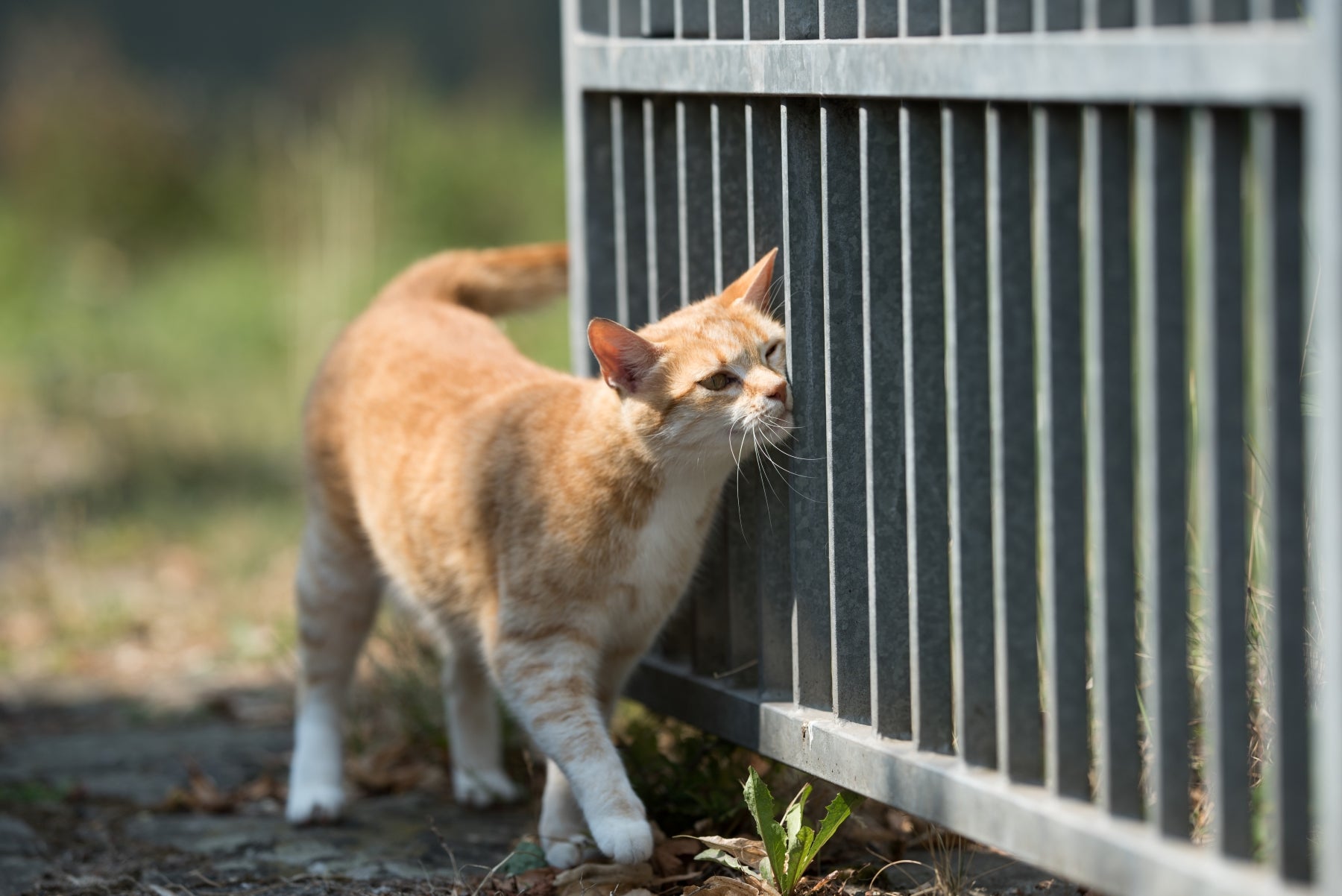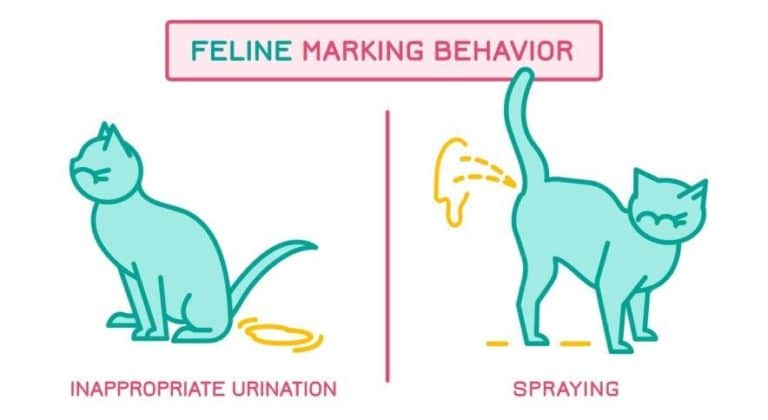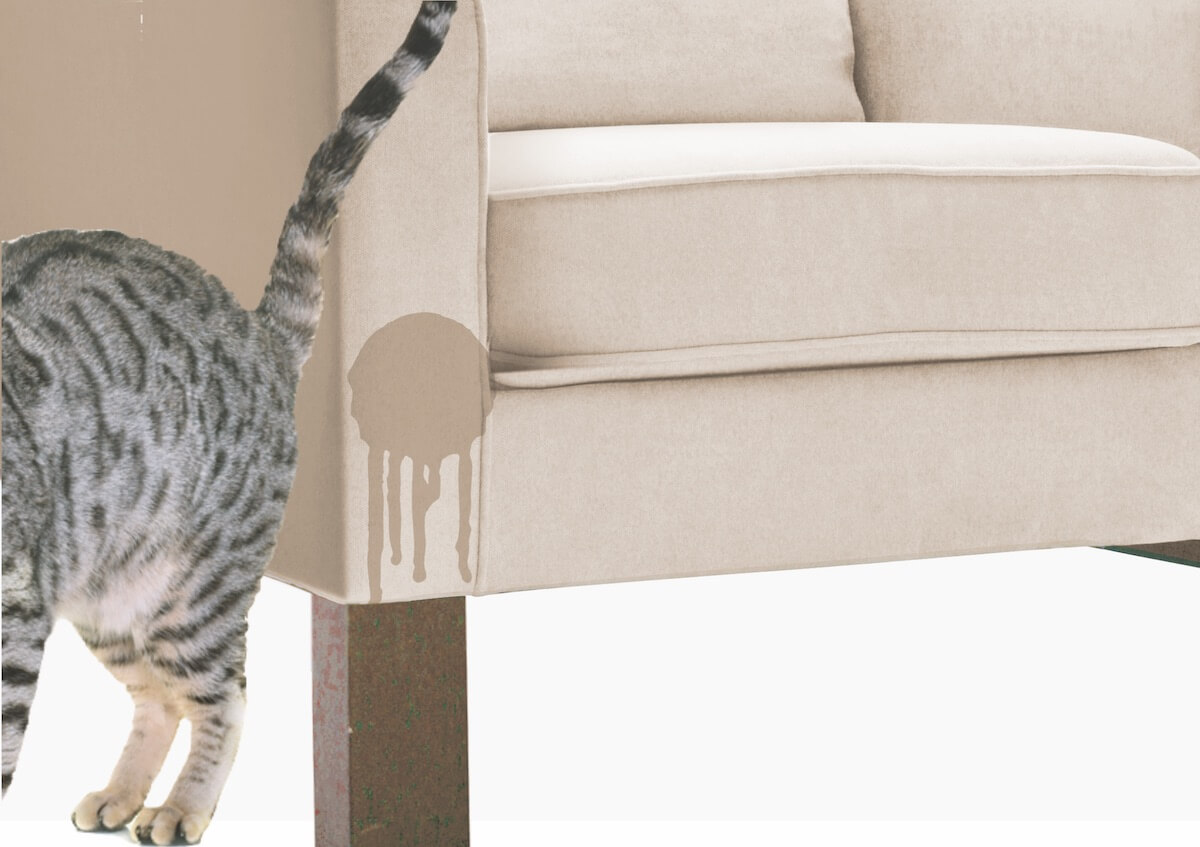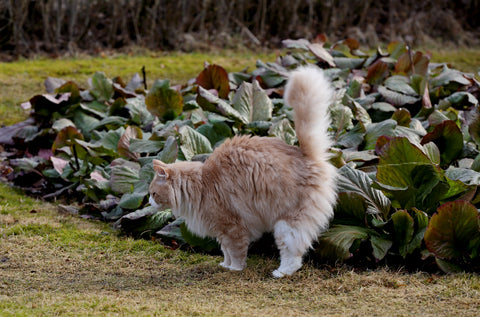Do you find yourself constantly battling with the unpleasant scent of your cat’s territorial markings inside your home? Fear not, as we have some helpful tips to put an end to this ongoing struggle. From understanding the reasons behind this behavior to implementing effective strategies, you’ll soon be able to create a peaceful, odor-free living environment for both you and your feline companion. So, let’s explore some simple yet effective methods to prevent your cat from marking territory inside the house.

Understanding Cat Marking Behavior
What is cat marking?
Cat marking refers to a behavior where cats use scent to communicate and establish their territory. It involves leaving distinct marks, such as urine or scratches, in specific areas within their environment.
Why do cats mark their territory?
Cats mark their territory for a variety of reasons. Primarily, it is a natural instinct that allows them to define boundaries and communicate with other cats. By marking their territory, cats convey essential information about their presence, reproductive status, and even their emotional state.
Different types of cat marking
There are several ways in which cats mark their territory:
-
Spraying: Spraying is a common form of marking behavior where cats release a small amount of urine, typically on vertical surfaces. This behavior is more common in unneutered or unspayed cats, but can also be seen in neutered/spayed cats.
-
Scratching: Cats have scent glands in their paws, and scratching serves as a visual and olfactory mark. By scratching on objects, cats leave behind visible marks and scent signals to claim the area as their own.
-
Rubbing: Through rubbing, cats transfer their scent onto objects or people. This behavior is often seen when a cat brushes against furniture, walls, or even their owners. It helps cats create a familiar and comforting scent in their environment.
-
Urinating outside the litter box: In some cases, cats may mark their territory by urinating outside their litter box. This behavior can be caused by various factors, including medical issues, stress, or the presence of other cats.
Identifying Marking Behaviors
Spraying
Spraying is one of the most noticeable marking behaviors in cats. It involves the cat standing up, lifting its tail, and releasing a small amount of urine against a vertical surface. Common targets for spraying include walls, furniture, and curtains. Male cats are more prone to spraying, especially if they are unneutered.
Scratching
Scratching is a natural behavior for cats, but it is also a way for them to mark their territory. Cats have scent glands on their paws, and when they scratch an object, they leave behind not only visible marks but also their scent. Scratching posts or designated scratching areas can help redirect this behavior and protect your furniture.
Rubbing
When a cat rubs against objects or people, they are leaving their scent as a way of marking their territory. This behavior is seen when a cat brushes their body, particularly the head and cheeks, against furniture, walls, or even their owners. It is a friendly way for cats to communicate and establish their presence.
Urinating outside the litter box
Cats may sometimes urinate outside their litter box as a form of marking behavior. This can be a result of various factors, such as stress, territorial disputes with other cats, or medical issues. It is essential to address the underlying cause and provide appropriate training and treatment to resolve this behavior.

Determining the Cause
Understanding why your cat is marking their territory is crucial in finding the appropriate solution. Here are some common causes to consider:
Medical issues
Some medical conditions, such as urinary tract infections or bladder stones, can cause cats to urinate outside the litter box. If your cat is exhibiting marking behavior suddenly or excessively, it is essential to consult with a veterinarian to rule out any underlying health problems.
Stress or anxiety
Cats are sensitive creatures, and stressful situations can trigger marking behavior. Changes in the environment, such as moving to a new home, introducing a new pet, or having visitors, can cause stress and anxiety in cats. Identifying and addressing these stressors can help alleviate marking behavior.
Environmental changes
Cats thrive on routine and familiarity. Sudden changes in their environment, such as rearranging furniture or introducing new scents, can disrupt their sense of territory. When making changes, it is essential to do so gradually and provide familiar scents and objects to help your cat adjust.
Unneutered or unspayed cats
Unneutered or unspayed cats are more likely to engage in marking behavior. The strong hormones in intact cats drive them to mark their territory more frequently and intensely. Spaying or neutering your cat can significantly reduce marking behaviors, especially in males.
Creating a Cat-Friendly Environment
To prevent or address marking behavior, it is essential to create a cat-friendly environment that satisfies their natural instincts. Here are some tips:
Providing multiple litter boxes
Having enough litter boxes in your home is crucial, especially in multi-cat households. The general rule is to have one litter box per cat, plus an additional one. Providing multiple litter boxes ensures that each cat has their own space to eliminate and reduces the likelihood of marking behavior.
Placing litter boxes strategically
Strategically placing the litter boxes can also help prevent marking behavior. They should be located in quiet and easily accessible areas, away from noisy appliances or high-traffic areas. Cats prefer privacy while using the litter box, so avoid placing them in open and exposed spaces.
Choosing the right type of litter
Cats have preferences when it comes to litter type. Experiment with different textures and materials to find the one that your cat prefers. Some cats prefer unscented litter, as strong fragrances may discourage them from using the litter box. Regularly clean and replace the litter to maintain cleanliness and odor control.
Keeping litter boxes clean
Maintaining a clean litter box is essential for preventing marking behavior. Scoop the litter box daily and change the litter at least once a week. Cats are naturally clean animals, and a dirty litter box may cause them to seek alternative elimination spots, including marking territory.

Implementing Behavior Modification Techniques
In addition to creating a cat-friendly environment, behavior modification techniques can help manage marking behavior. Here are some effective strategies:
Using pheromone sprays or diffusers
Pheromone sprays or diffusers, such as Feliway, emit synthetic pheromones that simulate the natural calming scents produced by cats. These pheromones can help reduce stress and anxiety, contributing to a decrease in marking behavior. They can be applied to specific areas or used throughout the home.
Providing vertical spaces and hiding spots
Cats love to climb and explore their environment. By providing vertical spaces such as cat towers, shelves, or perches, you give them the opportunity to claim territory at higher levels. Additionally, offering hiding spots, such as covered beds or enclosed spaces, can provide cats with a sense of security and reduce stress.
Engaging in interactive play
Regular playtime not only provides physical exercise but also mental stimulation for cats. Interactive play sessions using toys or laser pointers can help redirect your cat’s energy and reduce stress. Engaging in play before meal times can also mimic a cat’s natural hunting behavior, leaving them more satisfied and less likely to mark their territory.
Establishing a routine
Cats thrive on routine, as it provides them with a sense of security and predictability. Establishing a consistent schedule for feeding, playtime, and litter box maintenance can help reduce stress and prevent marking behavior. Stick to a schedule as closely as possible, and make gradual changes when necessary.
Addressing Medical Issues
If marking behavior persists or worsens despite implementing behavior modification techniques, it is crucial to consult with a veterinarian. They can thoroughly examine your cat and determine if any underlying medical issues are contributing to the marking behavior. Treating these health problems will help alleviate the behavioral symptoms and promote overall well-being.

Managing Stress and Anxiety
Stress and anxiety can be significant factors in marking behavior. Here are some strategies to help manage and reduce stress in cats:
Identifying stress triggers
Observe your cat’s behavior and identify any specific triggers that may cause stress. These triggers could be new pets, loud noises, or changes in the environment. By identifying what stresses your cat, you can take proactive steps to minimize their exposure to those stressors.
Creating a calm and safe environment
Provide a safe and stress-free environment for your cat. Create designated areas where they can retreat when feeling overwhelmed. Use soft bedding, provide hiding spots, and create a quiet space away from noisy household activities. Consider using white noise machines or calming music to mask stressful sounds.
Using calming aids or supplements
Calming aids, such as pheromone products or herbal supplements, can help alleviate stress and anxiety in cats. Consult with your veterinarian to determine the most appropriate options for your cat. These aids can be used in conjunction with behavior modification techniques to provide a holistic approach to reducing marking behavior.
Dealing with Environmental Changes
When major changes occur in your cat’s environment, it is crucial to introduce them gradually to prevent stress and marking behavior. Here are some tips for managing environmental changes:
Introducing changes gradually
If you are moving to a new home, or making significant changes to the existing environment, introduce them gradually. Give your cat time to acclimate to new scents, sights, and sounds. Set up familiar objects and provide a sense of familiarity to help ease the transition.
Maintaining a consistent environment
Cats thrive on routine and familiarity. Try to maintain a consistent environment as much as possible. Stick to a consistent schedule for feeding, playtime, and interactions. Minimize changes in furniture arrangement or household routines to reduce unnecessary stress.
Offering familiar scents and objects
When introducing changes, provide your cat with familiar scents and objects. This can include using their bedding, toys, or scratching posts from the old environment. Familiar scents will provide comfort and reassurance to your cat during the transition.

Spaying or Neutering Your Cat
If your cat is not already spayed or neutered, considering this procedure can have significant benefits in reducing marking behavior. Spaying or neutering helps regulate hormone levels and reduces the instinctual drive to mark territory.
Understanding the benefits of spaying/neutering
Spaying or neutering your cat has numerous health benefits, including a reduced risk of certain cancers and behavioral issues. In addition to preventing hormone-driven marking behaviors, it also helps control the cat population and reduce the chances of unwanted litters.
Preventing hormone-driven marking behaviors
Unneutered male cats have a strong instinct to mark their territory, leading to excessive spraying behavior. Neutering helps reduce this instinctual drive, making it less likely for your cat to engage in marking behaviors. Spaying also eliminates the urge for female cats to mark during their heat cycle.
Consulting a Professional
If you have tried various techniques and still struggle with marking behavior, it may be beneficial to seek professional help from a veterinarian or animal behaviorist. These experts can provide personalized advice and guide you through advanced training techniques to address the specific needs of your cat.
Seeking help from a veterinarian or animal behaviorist
A veterinarian or animal behaviorist can assess your cat’s behavior, identify underlying causes, and create a customized plan to address marking behavior. They may suggest additional behavior modification techniques or recommend medication, depending on the severity of the issue.
Exploring advanced training techniques
In some cases, advanced training techniques may be necessary to address persistent marking behavior. These techniques can include desensitization and counterconditioning exercises to help change your cat’s emotional response to triggers that lead to marking. With professional guidance, you can work towards resolving the issue and creating a harmonious living environment for you and your cat.
Preventing and addressing marking behavior requires patience, understanding, and a proactive approach. By creating a cat-friendly environment, addressing underlying issues, and seeking professional help when needed, you can effectively manage and reduce marking behavior in your beloved feline companion.
